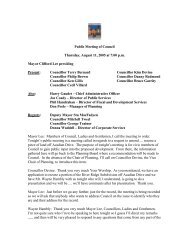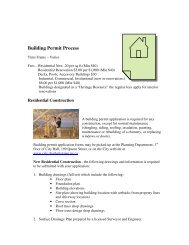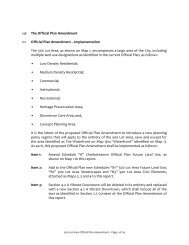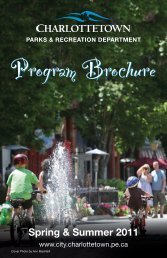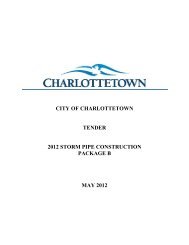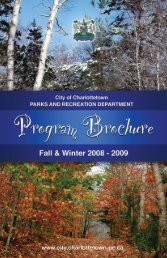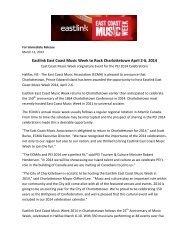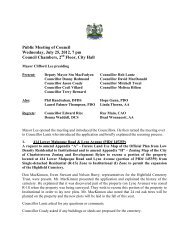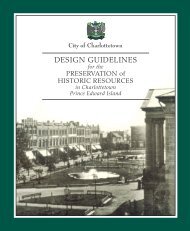Victoria_Park_Re port Final.pdf - City of Charlottetown
Victoria_Park_Re port Final.pdf - City of Charlottetown
Victoria_Park_Re port Final.pdf - City of Charlottetown
You also want an ePaper? Increase the reach of your titles
YUMPU automatically turns print PDFs into web optimized ePapers that Google loves.
VICTORIA PARK COMPREHENSIVE MASTER PLAN<br />
<strong>Final</strong> <strong>Re</strong><strong>port</strong> • June 2013<br />
Archeological Guidelines<br />
<strong>Victoria</strong> <strong>Park</strong> is on a site that has a high potential for archeological assets. There has<br />
been well documented evidence for archeological resources that date from the mideighteenth<br />
century up to the twentieth century. Although there are no known First<br />
Nations sites delineated within the park, there is potential that resources that pre-date<br />
the establishment <strong>of</strong> <strong>Charlottetown</strong> could exist, including French, Acadian, Mi’kmaq, or<br />
pre-contact First Nations assets.<br />
Two specific areas within the park have been identified by the archeological scoping<br />
work that was done as part <strong>of</strong> this comprehensive planning process. The Fort Edward<br />
Battery, and the area surrounding Government House have high potential for existing<br />
resources. Prior to any physical site work being planned for these areas the <strong>City</strong> (or<br />
Province, in the case <strong>of</strong> Province House) should consult with a qualified archeologist. It<br />
may also be worthwhile to undertake a more in-depth review <strong>of</strong> the archeology at Fort<br />
Edward, if not already completed, to enhance the interpretive experience at this site.<br />
Monuments, Memorials, and Public Art<br />
As one <strong>of</strong> the <strong>Charlottetown</strong>’s most im<strong>port</strong>ant park spaces, there is a natural inclination<br />
by the community to want to use the park as an op<strong>port</strong>unity for commemoration.<br />
There are already a number <strong>of</strong> memorials and dedications within the park, and <strong>City</strong><br />
regularly receive requests for further op<strong>port</strong>unities. Memorialization is an op<strong>port</strong>unity<br />
to differ the costs for infrastructure or asset improvement or development in the public<br />
realm. The challenge with this approach is that without an overarching policy, the park<br />
can become a jumble <strong>of</strong> memorials without a cohesive vision, and the operational and<br />
maintenance demands <strong>of</strong> these dedications can become taxing to the <strong>City</strong>.<br />
The <strong>City</strong> <strong>of</strong> <strong>Charlottetown</strong> should adopt a policy for memorialization in <strong>Victoria</strong> <strong>Park</strong>,<br />
looking at restricted applications to ensure appropriate installations. For any large<br />
scale installations or the establishment <strong>of</strong> naming rights, a time lag <strong>of</strong> 25 years should<br />
have elapsed between the event or person and the installation <strong>of</strong> the memorial. This<br />
policy would specifically apply to memorial sites or naming rights, and not small scale<br />
site furnishings or memorial trees. In such a case where an application for a memorial<br />
or naming right dedication is made, the decision should be reviewed by the governing<br />
body for <strong>Victoria</strong> <strong>Park</strong>. It is im<strong>port</strong>ant that the rationale for any new memorial be<br />
significant and closely related to the <strong>City</strong> <strong>of</strong> <strong>Charlottetown</strong>. In addition, there should<br />
be a compelling reason why the memorial should be established within the park and<br />
not elsewhere in the <strong>City</strong>. For such large scale installations, the donation or dedication<br />
must also include a provision for the ongoing maintenance <strong>of</strong> the memorial, to ensure<br />
that over the long-term it does not become overly cumbersome for the <strong>City</strong>. When<br />
evaluating memorial applications, a qualified landscape designer should be consulted<br />
to ensure that the proposed design does not detract from the character and aesthetic<br />
quality <strong>of</strong> the site within the park.<br />
56



